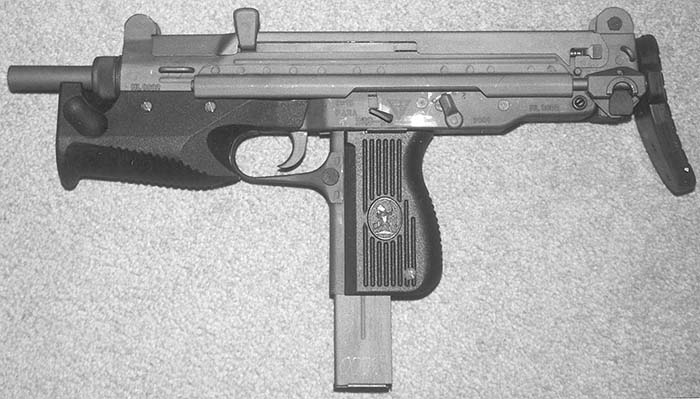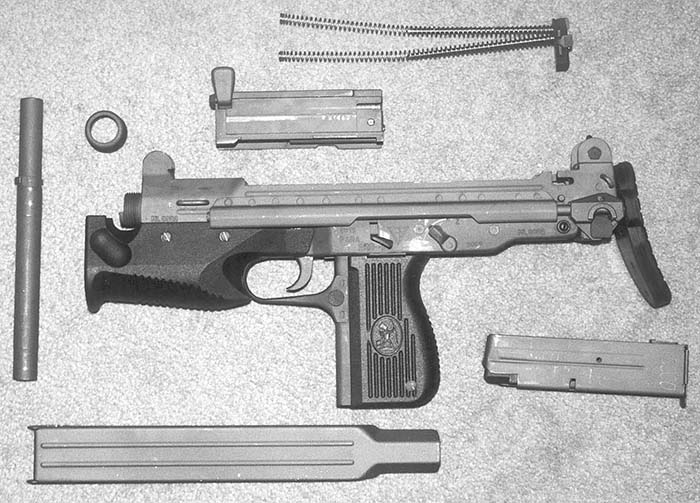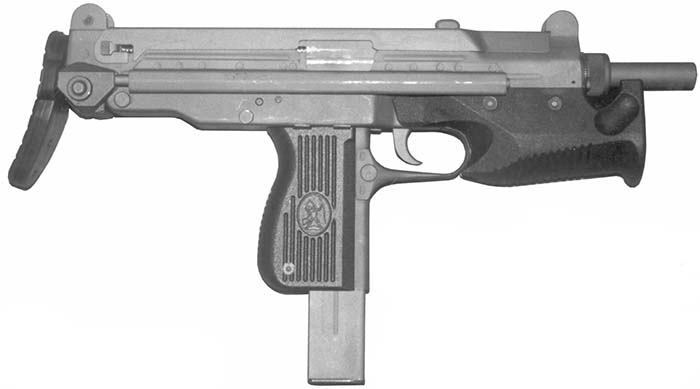by Warren Ferguson
Most shooters are familiar with the selective-fire Uzi submachine gun – battle winner and presidential defender. Now, the Polish firm of Lucznik-Radom has unveiled its latest Uzi-type carbine, the BRS-99. It’s Uzi meets AKM meets Autoloading Pistol and is an excellent product improvement over its originator, the Uzi. The BRS-99 modernizes the Israeli design to create a new weapon that fits the most stringent NATO specifications and police tactical unit requirements.
The BRS-99 comes down the line of several Uzi-type Polish submachine guns. That is interesting since the Warsaw Pact countries across the board had for decades been using AKMs and by the late 1980s would switch over to AK-74U (wz89) varieties of submachine guns.
Engineers from Z.M. Radom developed the Pm-84 “Glauberyt” in the early 1980s. It was blowback-operated and very similar to the Uzi. The forward part of the bolt wrapped around the chamber, the magazine fit into the pistol grip, and so forth. The Pm-84 was also constructed out of sheet metal stampings, making it easy and cheap to manufacture. Only the bolt, sear, hammer and the barrel required machining.
From the outset, the Pm-84 fired from the closed bolt and chambered the 9mm Makarov cartridge. The trigger mechanism sat in the rear part of the lower receiver and was controlled by a selector/safety lever located on the left side of the receiver.
There was also an inertia-operated retarding device in the lower receiver that reduced cyclic fire rate to about 600 rpm. A forward folding pistol grip (like the Pm-63) was fitted along with a retractable wire stock.
The sights had four setting: two for 75 meters (one open and one peep), 150 and 200 meters. Two handles located at both sides of the receiver loaded the weapon. Standard equipment consisted of a carrying belt, a canvas holster, magazine pouch and four magazines (one 15-round and three 25-round).
The Pm-84P is the 9mm Parabellum variant and therefore the bolt and construction is heavier. Submachine guns manufactured recently have additional layers of metal added to the sides of the receiver that partially cover the folding stock in retracted position. Both the Pm-84 and Pm-84P were offered in semiautomatic-only variants for police duty. The Pm-84P, as well as the newer and refined Pm-98, are used by the Polish military and will ultimately replace the Pm-63.

Who is Lucznik-Radom?
Lucznik-Radom carries on the excellent histories of Fabryka Broni Radom and Zaklady Metalowe Lucznik. Radom is known for its famous wz 1935 pistol and initially Lucznik-manufactured items for Polish military requirements and also bicycles and machine tools such as sewing machines.
Examining firearms from Poland, one will most often find them marked with the number “11” in an oval. This is the factory marking of Zaklady Metalowe LUCZNIK S. A., which is located in the city of Radom. Zaklady Metalowe Lucznik has been making Kalashnikov clones for many years and is now marketing weapons re-chambered for 5.56x45mm NATO ammunition under the name wz90 Tantal.
The Tantal is like the AK74, but houses a new trigger mechanism. The Kalashnikov selector switch is now used as a safety and a selector switch has been moved to the left side of the rifle with full-auto, semiautomatic and 3-shot burst settings. The improved wz96 Beryl has an optics mount on top of the receiver cover and an 18-inch barrel.
On the BRS-99, the Fabryka Broni symbol of an FB within a triangle is found along with the name BRS-99, the caliber, but no country of origin or importer. Matching serial numbers are located on the upper and lower receivers, inside of the top cover, bolt and barrel.
Why exactly is Lucznik-Radom selling military arms abroad or even taking the time to develop the BRS-99 semiautomatic carbine? This is because Polish authorities want to develop an export orientation, replace old equipment to ensure interoperability with NATO forces, open the Polish economy to foreign capital, and lead the way for the ultimate financial stabilization of Poland’s defence industries.
The Poles are actively trying to boost sagging arms exports and so the BRS-99 is part of that strategy. The number of countries embargoed by the United Nations has increased recently, and, along with the dissolution of the Warsaw Pact, contracts for Polish arms have decreased and so there has been a shift in sales policy. To save one its largest sources of income, weapons have been modernized and made to NATO specifications. Meanwhile, Poland is in the process of legitimizing its arms industry and has worked to minimize black market weapons sales (said to be about 1/3 of all weapons shipments from Poland now) to meet Western ethics.
Poland is doing its best to move toward market liberalization and privatization, but many of its defence firms are large and employ thousands of workers. The estimated debt of the arms sector exceeds 1 billion zlotys or nearly one half of the value of the firms. Many of the largest companies have hovered on the brink of bankruptcy. Some analysts suggest that in order to survive, defence firms should generate approximately $80,000 in revenue per employee.
In the interim, Poland needs arms sales to pay its unionized and vocal workers. Lucznik workers in recent years have missed months of wages and have picketed the Treasury and Economy Ministries in Warsaw for more state orders for their products. Currently, Lucznik’s 4,000-strong work crew wants the government to order 15,000 rifles that can meet NATO military standards.
With all this at play, the end result is a willingness to make very good military weapons for the end user.

Why refine the Uzi?
One strategy Poland is following in lieu of large exports is to purchase licenses to manufacture Western equipment. This way, the national defense infrastructure and employment is maintained while gaining access to advanced technology. The Poles are also looking to improve existing equipment and so the Uzi is a natural starting point for the Pm-98 and the BRS-99.
You will recall that the Uzi came about during the 1950s in Israel’s primitive economy and arms industry. It takes a lot from the Czech vz23 and vz25 SMGs. Soldiers liked its compactness and the location of the magazine housing inside the pistol grip. By placing more weight over the chamber upward climb during recoil was reduced.
The weapon has natural pointing traits because the point of balance is directly above the grip. The Uzi magazine, an adaptation from Beretta submachine guns, is of the two-position-feed type. This makes it easy to load and minimum bolt energy is required to strip rounds from this type of magazine. With these excellent characteristics, why reinvent the wheel?
The BRS-99
The BRS-99 is related to the Uzi, but cannot be mistaken for one. The BRS-99 is grey phosphate finished and comes with a canvas hip/thigh holster and as such makes it useful for armoured vehicle crews where an assault rifle is too cumbersome. It also comes with a sling, cleaning kit, 15-round magazine and a magazine pouch with three additional 25-round magazines.
The magazines are Uzi type but lighter and support a last shot hold-open device designed into the carbine. This hold-open device itself makes the BRS-99 a superior improvement over the Uzi or even the MP5. Compared to an Uzi magazine, the BRS-99 magazine is cut and opened up on the left side, the follower has a detent for the hold-open device, and it locks into the pistol grip by a thumb-activated release, much like an autoloading pistol. The magazine release button can be applied in reverse for southpaws, and so the magazine has locking cuts in both sides of the magazine. The user can easily determine the number of rounds in the magazine by inspecting the view holes numbered 2,5,7,9,11,13,15,21 and 25.
The BRS-99 is a semiautomatic-only 9x19mm Parabellum carbine with a fire selector marked “Z” for safe and “P” for single shot. Unlike previous models, there is only one cocking handle and it is on the left side of the receiver. Upon firing, the empty casing is ejected to the right with considerable force due to its fixed ejector.
The BRS-99 has a plastic pistol grip with an Egyptian archer logo on it and a large plastic modular fore grip that can optionally fit within it a Lucznik laser sight, or an American Sure Fire L-60 tactical light.
The folding stock is made of wire but is actually more rigid than it looks. It is pulled out of the receiver and pivoted down until it locks. An AKMS-type button locks it. The stock is longer than the Uzi’s and therefore quite comfortable but not as robust. The butt is covered with non-slip rubber padding.
Southpaws using the trigger finger can reach the magazine release and hold-open device with ease, but not the safety. This oversight should be corrected if the Poles are serious in making a modern firearm. There is no provision for a bayonet on the BRS-99.
Unlike the Pm-84, there are only two sight settings on the BRS-99 – a notch for 75 meters and peep for 150 meters. The front sight is a post-type and it can be adjusted. The receiver is stamped sheet metal and the lower receiver separates much like that of the Uzi. The trigger/hammer/sear arrangement is clearly Kalashnikov inspired.
How does BRS-99 compare?
It is inevitable that the BRS-99 will be compared with other Uzi-type firearms. Even Uziel Gal, the Uzi’s designer, was not satisfied with the Uzi and looked to improve it. The main change would be to lighten the Uzi, offer closed-bolt operation as an option, and make it more compact. Add compensating slots in the top of the muzzle and you have the Mini Uzi. Even smaller, the Micro Uzi is too tiny to be useful by a military force, but two other Uzis are noteworthy.
A Mini Uzi variant is offered in 9mm and .40 S&W as the Uzi America/Mossberg First Responder Police Carbine/Individual Officer Carbine. The two are identical closed bolt carbines except for barrel length. What we have here is a Mini Uzi with a fixed stock for police duty.
The Ruger MP-9 was Uziel Gal’s latest vision for a lighter, more compact and enhanced Uzi. Gal (of URDA) contracted Canada’s Diemaco to work with him in the design of his new submachine gun designated the 201, or as it is unofficially called, the NEWZI. The complete design was finished at Diemaco under his supervision and a final set of toleranced production drawings, tooling, and prototype test samples of the weapon were produced.
This was a 9mm or 10mm submachine gun that had a low rate of fire, was holsterable and could be fired off hand with good accuracy. Diemaco worked for about a year and a half on this project. When military sales were not forthcoming for the UZI 201, the URDA sold the rights, tooling and technical data to Ruger, which now produce the weapon.
The MP-9 is fired from the closed bolt to increase accuracy. The lower receiver is made from Zytel polymer while the upper receiver is made from stainless steel. The buttstock is redesigned to fold and telescope.
With the BRS-99, you have the best Uzi variant. It is the lightest, has a hold-open device, is accurate due to its closed-bolt operation, is mostly ambidextrous, its magazines fall free when the magazine release button is depressed, and is designed from the beginning to be optically enhanced.
The BRS-99 grips are ergonomically designed, but a fixed butt stock option would be beneficial. That is because the stock is functional but nowhere as good as the Uzi’s. Perhaps the Poles can make a modular two-piece stock that goes over the wire stock?
The magazine-well of the BRS-99 is bevelled at the front, but the firearm would be improved if it were more flared. The magazines do not have side stoppers like Uzi magazines (but one rear) and so this could easily be achieved.
Considering the firearm in its Pm-99 form, its 640-rpm rate is useful and not wasteful. It seemed that the enhanced Uzis just kept getting faster and faster.
On the Range
The BRS-99 is definitely a curiosity at the local range and many onlookers wanted to see how it worked – somewhat unidentifiable short-barrelled military rifles can do that.
The double-column magazine loads easily and slides easily into the pistol grip. The safety is switched to “P” since the bolt cannot move otherwise. Grasping the cocking handle, pull the bolt to the rear and release. The bolt will move forward upon spring influence and load the chamber. This is a closed-bolt weapon with an internal hammer and so the chamber is now loaded and no dirt can enter through the ejection port.
For the test and evaluation, both Winchester 115-grain FMJ and Spanish Santa Bárbara 112-grain FMJ cartridges were used. During the test, there were no failures in this new-in-the-box test sample whatsoever. Each empty case ejected out the large ejection port and landed about 15 feet to the right.
When used as a rifle, accuracy was quite acceptable. For the test, four groups of five rapid shots were initially placed on target at 50 meters. These groups averaged 2.7 inches with both loads. The trigger was firm and consistent with every shot. The BRS-99 was then shot at 100 and 150 meters, where the 100-meter (109.36-yard) groups averaged 12.19 centimetres (4.8 inches). These results were, of course, using only the iron sights and so one wonders what is possible with the Lucznik laser and/or an Aimpoint.
The magazine follower operates a plunger that retains the bolt in the rear position when the ammunition supply is exhausted. Press the magazine release button and the empty magazine literally kicks out of the pistol grip. Inserting a fresh magazine and depressing the Hold Open Device brings the bolt forward.

Field stripping
The BRS-99 strips very easily. Anyone familiar with the Uzi or AKs can do it on first sight. First, the recoil buffer apparatus is exposed on both sides of the receiver where it locks inside two channels. To remove the top cover, move this “breech casing cover catch” forward and down. Pull upward at the rear portion of the top cover and the cover comes off where it locks in a slot at the front (like the AK). Press the breech casing cover catch forward to unhook it, and remove the spring assembly. Pull the bolt to the rear until it is free from its rails. Lift and remove the bolt. Press the barrel nut catch and unscrew the barrel nut. Draw out the barrel from the receiver. Next, only if needed, press out the connector/expander pin on the lower receiver that connects the upper and lower receivers. The fore stock is removed with a screwdriver.
One will notice the obvious features of a closed bolt weapon: it has a spring-retracted firing pin like a pistol and not a fixed firing pin like most submachine guns. The bolt handle is fixed to the bolt. The trigger group is responsive and reminiscent of the AKM.
Worthy successor?
The Uzi is without a doubt a great military firearm. Yet the Poles are hungry to put their Communist ways behind them and make great guns for the open market. For many years, unsavoury nations like Yemen, Sudan, Somalia and Eritrea have been the main recipients of Polish weapons. For fear of a negative reaction from its NATO allies, Poland is looking to new markets (the Poles don’t even make 5.45x39mm ammo anymore). It also has a highly trained work force eager to maintain profitability during restructuring and privatization in order to keep their own jobs.
As a result, Polish arms are very good. With the Pm-99 and BRS-99, Lucznik-Radom has created a reliable and accurate firearm with the best characteristics of the Uzi. The Uzi is hence taken to its pinnacle, perfected and modernized to be the next generation of pistol caliber close quarters combat weaponry.
Additional color photographs of the BRS-99 and an MPEG video can be found at www.blackpowdersports.com/writer.htm. The author can be contacted at wfpaddy@hotmail.com.
| This article first appeared in Small Arms Review V7N9 (June 2004) |










